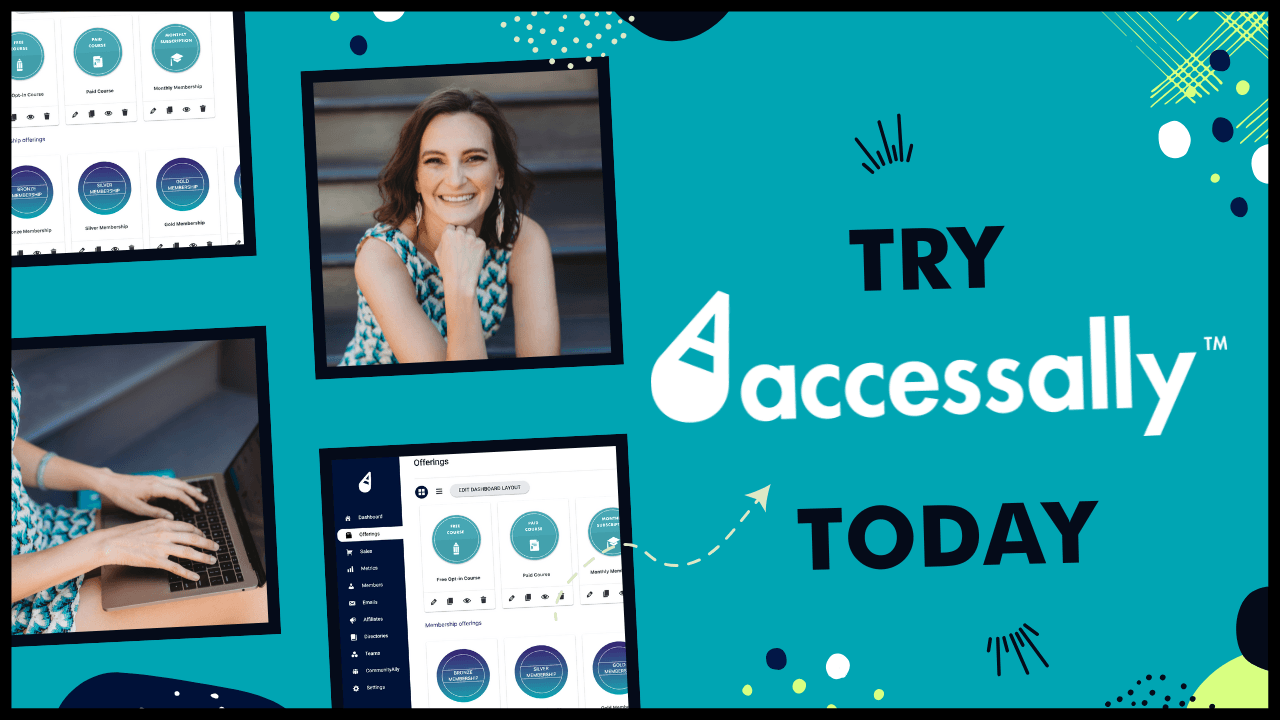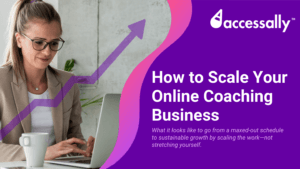Introduction and Overview: Creating High-Converting Landing Pages
Let’s talk about the make-or-break moment in your online course business: your landing page. When done right, a landing page transforms casual browsers into eager leads, setting the foundation for a thriving course ecosystem. But creating that perfect landing page isn’t just about throwing together some compelling copy and a shiny button – it’s about understanding the psychology behind what makes visitors take action.
Think of your landing page as your digital storefront. Just as a physical store carefully arranges its window display to draw people inside, your landing page needs to strategically present your course offering in a way that resonates with your ideal students. The key difference? You have mere seconds to capture attention and convince visitors to take the next step.
Unfortunately, many creators focus solely on aesthetics, missing the crucial elements that drive conversions. Your landing page needs to address three fundamental questions: What problem are you solving? Why should visitors trust you? And what specific action should they take next? Understanding these core components will help you create a page that not only looks professional but actually delivers results.
The most successful landing pages share common characteristics: clear, benefit-focused headlines, compelling social proof, strategic use of white space, and carefully crafted calls-to-action. But it’s not just about including these elements – it’s about presenting them in a way that creates a natural flow, guiding visitors toward your desired conversion goal.
Throughout this guide, we’ll explore proven strategies for optimizing each component of your landing page. From crafting headlines that stop the scroll to designing forms that people actually want to fill out, you’ll learn practical techniques you can implement immediately. We’ll also look at common mistakes to avoid and how to test different elements to continuously improve your conversion rates.
Remember, your landing page isn’t just another website – it’s a crucial business tool that can either amplify or diminish everything else you’re doing to grow your course business. By the end of this guide, you’ll have a clear roadmap for creating landing pages that not only attract visitors but convert them into valuable leads for your online course.
Foundation Concepts and Planning
Before diving into the technical aspects of landing page creation, let’s establish the core foundations that will set you up for success. When done right, your landing page should feel like a natural conversation with your ideal student, guiding them toward a decision that genuinely benefits their goals.
| Feature | Benefit | Use Case |
|---|---|---|
| Drip Content | Increases engagement | Course progression control |
| Quiz & Assessments | Validates learning | Student progress tracking |
| Certificates | Motivates completion | Professional development |
| Community Access | Builds loyalty | Student interaction |
Start by defining your landing page’s singular purpose. Are you promoting a signature course, offering a free workshop, or launching a membership program? This clarity will influence every element of your page, from headline to call-to-action. Remember, trying to accomplish multiple objectives on one landing page typically leads to confusion and reduced conversion rates.
Next, develop a deep understanding of your target audience’s current situation. What specific challenge are they facing? What solutions have they already tried? What’s holding them back from achieving their goals? This insight helps you craft messaging that resonates on an emotional level, showing visitors you truly understand their struggles and aspirations.


Your value proposition needs to be crystal clear and immediately visible. Think about what makes your offering unique. Is it your teaching methodology? Your community support? Your proven results? Whatever it is, articulate it in simple, benefit-focused language that speaks directly to your prospect’s desires.
Consider the psychological journey your visitor needs to take. They’ll arrive with certain objections and hesitations. Map out these concerns and address them proactively through your content. This might include social proof elements like testimonials, specific outcome examples, or detailed explanations of your teaching approach.
The technical structure of your landing page matters just as much as the content. Plan your page hierarchy with intention – what information needs to come first? What supporting elements will build trust? How will you maintain momentum toward your call-to-action? Create a rough wireframe that outlines these elements before you start building.
Don’t overlook the importance of your offer structure. Whether you’re selling a course or collecting leads for a free resource, ensure your offer feels valuable yet achievable. Break down complex programs into digestible modules, or highlight the quick wins from your free content. This helps visitors envision themselves succeeding with your solution.
Finally, establish your success metrics before launch. While conversion rate is obvious, consider other valuable indicators like time on page, scroll depth, and exit points. These metrics will help you optimize your page over time, turning it into an increasingly effective tool for growing your course business.
Step-by-Step Implementation Guide
Let’s break down the process of creating a high-converting landing page into manageable steps that you can implement today. When done right, your landing page will become a powerful lead generation tool that works around the clock to grow your course business.
Start by identifying your ideal student’s primary pain point. This isn’t just about listing problems – it’s about understanding the emotional journey that brought them to your page. Are they frustrated with their current skill level? Looking to make a career change? Your landing page should immediately acknowledge this pain point in the headline and opening paragraph.
Next, craft your unique value proposition. This isn’t just what you’re offering, but why it matters to your potential students. Instead of saying “6-week course on digital marketing,” position it as “Master digital marketing in 6 weeks and land your dream clients.” Notice how the second version speaks directly to the outcome your students desire.
Your landing page’s visual hierarchy is crucial for guiding visitors toward conversion. Place your most compelling benefit above the fold, followed by social proof elements like testimonials or success stories. Remember to use white space effectively – cramming too much information into one area can overwhelm visitors and decrease conversion rates.
The enrollment process should be crystal clear. Create a prominent call-to-action button that stands out from your page’s color scheme. Use action-oriented language like “Start Your Journey” or “Secure Your Spot” rather than generic phrases like “Sign Up” or “Submit.” Position your CTA button multiple times throughout the page, especially after compelling benefit sections.
Include trust-building elements strategically throughout your page. This means showcasing real results from past students, displaying relevant credentials, and potentially including a money-back guarantee. These elements help overcome the natural hesitation people feel before making an investment in their education.
Your landing page copy should follow the PAS framework: Problem, Agitation, Solution. Start by identifying the problem your potential students face, agitate that pain point by highlighting the consequences of not addressing it, then present your course as the ideal solution. This psychological framework creates emotional resonance and motivates action.
Finally, implement a testing strategy to continuously improve your landing page’s performance. Set up A/B tests for different headlines, CTAs, and testimonial placements. Track your conversion rates and make data-driven decisions about what stays and what goes. Remember that landing page optimization is an ongoing process, not a one-time task.
Advanced Strategies and Techniques for High-Converting Landing Pages
When done right, your landing page becomes a powerful conversion machine that works around the clock to transform casual visitors into engaged leads. Let’s dive into some sophisticated strategies that go beyond the basics to dramatically improve your conversion rates.
Start by implementing dynamic content personalization. Rather than showing the same message to everyone, adjust your landing page content based on visitor behavior and source. For example, if someone arrives from a Facebook ad about beginner photography courses, show them testimonials and benefits specifically related to photography basics. This level of personalization can increase conversion rates by up to 30%.
Heat mapping and user session recordings are your secret weapons for optimization. Install tools like Hotjar or Crazy Egg to watch exactly how visitors interact with your page. Pay special attention to scroll depth, click patterns, and where people pause to read. I’ve seen countless course creators discover that their crucial call-to-action button was sitting just below where 80% of visitors stopped scrolling.
A/B testing should become your new best friend, but approach it strategically. Instead of testing minor elements like button colors, focus on testing significant variables that can truly move the needle. Test different value propositions, headline approaches, and social proof formats. Consider creating two completely different page narratives – one focusing on pain points and another on aspirational outcomes – to see which resonates better with your audience.
Implement a strategic exit-intent strategy that goes beyond the basic popup. Create a multi-step exit sequence that first offers valuable content, then follows up with a smaller commitment option, and finally presents a time-sensitive offer. This approach can recover up to 15% of abandoning visitors.
One often overlooked technique is the strategic use of micro-commitments. Before asking for an email address, get visitors to engage with interactive elements like a quick quiz or calculator. This builds psychological investment and can significantly boost conversion rates. For example, a course platform I worked with increased conversions by 45% by adding a “course fit calculator” before their main lead capture form.
Most importantly, ensure your landing page seamlessly integrates with your broader course delivery system. Tracking student progress effectively starts with proper data collection at the landing page level. Design your forms to gather information that will help personalize the learning experience from day one.
Remember to regularly audit your landing page’s loading speed and mobile responsiveness. A one-second delay in page load time can reduce conversions by 7%. Test your page across different devices and connections, and optimize images and scripts accordingly.
Common Challenges and Solutions
Creating high-converting landing pages isn’t always smooth sailing, and I’ve seen course creators encounter several recurring challenges. Let’s tackle these head-on with practical solutions that you can implement today. If you’re feeling stuck with your landing page performance, know that you’re not alone – and more importantly, every challenge has a workable solution.
One of the most common hurdles is information overload. Many course creators try to pack everything about their program onto the landing page, overwhelming potential students. Instead, focus on the three most compelling benefits and elaborate on those. For example, rather than listing 15 module titles, highlight how your course helps students achieve specific outcomes like “master Facebook ads in 30 days” or “launch your first profitable online store.”
Another frequent challenge is misaligned messaging. Your landing page might be attracting plenty of visitors, but they’re not converting because the content doesn’t speak directly to their pain points. The solution is to conduct customer interviews and gather testimonials that reflect real student experiences. Use their exact words in your copy – this creates an immediate connection with new prospects who share similar challenges.
Technical difficulties often plague course creators, particularly when it comes to mobile responsiveness and page load speed. Unfortunately, many creators overlook these fundamental aspects. Ensure your landing page loads in under three seconds and test it across multiple devices. Consider using a tool like Google’s Mobile-Friendly Test to identify and fix any issues that could be driving potential students away.
Weak calls-to-action (CTAs) can significantly impact conversion rates. Rather than generic phrases like “Sign Up” or “Learn More,” make your CTAs specific and value-driven. “Start Your Journey to $10K Months” or “Join 1,000+ Successful Students” creates more emotional impact and urgency.
Finally, many landing pages suffer from a lack of social proof or present it ineffectively. The solution is to strategically place testimonials, success stories, and results throughout the page, not just in a dedicated section. When done right, this approach creates a natural flow that builds trust as visitors scroll through your content, making them more likely to take action and enroll in your course.
Best Practices and Optimization
When done right, your landing page can become a powerful lead generation engine that works around the clock. The key is focusing on both the technical and psychological elements that drive conversions. Let’s explore the proven optimization strategies that can transform your visitor-to-lead ratio.
Start by implementing a clear visual hierarchy that guides visitors’ eyes naturally down the page. Your headline should immediately communicate value, followed by supporting subheadings that break up content into digestible sections. Use contrasting colors for your call-to-action buttons, but keep the overall color scheme consistent with your brand identity to maintain trust and recognition.
Loading speed is crucial for keeping visitors engaged. Compress your images, minimize plugins, and leverage browser caching to ensure your page loads in under three seconds. Mobile optimization is equally important – test your landing page across different devices and screen sizes to guarantee a seamless experience for all visitors.
Social proof plays a vital role in building credibility. Include testimonials from successful students, but be strategic about placement. Position your strongest testimonial near the main call-to-action, and spread others throughout the page to reinforce your value proposition at different decision points. Consider adding a video testimonial – they typically increase conversion rates by 86%.
Your form design deserves special attention. Only ask for essential information – each additional field reduces conversion rates by approximately 4%. If you need more details, consider using a multi-step form that feels less overwhelming. Place your form above the fold on desktop views, and ensure it’s easily accessible on mobile devices.
A/B testing is your secret weapon for continuous improvement. Test one element at a time – whether it’s headline variations, button colors, or form layouts. Give each test enough time to gather statistically significant data before making changes. For detailed guidance on creating effective online courses that complement your landing page, check out this comprehensive WordPress course creation guide.
Remember to analyze your analytics regularly. Pay attention to bounce rates, time on page, and scroll depth. These metrics can reveal where visitors lose interest and help you identify opportunities for improvement. Heat mapping tools can provide additional insights into how visitors interact with your page elements, helping you optimize placement and design for maximum impact.
Case Studies and Examples: Landing Page Success Stories
Let’s dive into some real-world examples that showcase how strategic landing page optimization can dramatically improve conversion rates. When done right, even small changes can lead to significant improvements in your lead generation efforts.
Take Sarah, a business coach who was struggling with a 2% conversion rate on her landing page for a high-ticket program. By implementing a clear before-and-after transformation story at the top of her page and adding social proof elements from past students, she increased conversions to 8.5%. The key was leading with specific results: “From struggling solopreneur to booked-out consultant in 90 days” resonated deeply with her target audience.
Another compelling example comes from Marcus, a fitness instructor who initially focused solely on listing course features. His landing page was technically perfect but converted at just 1.3%. After restructuring the page to address his audience’s emotional pain points and adding a video demonstration of his teaching style, conversions jumped to 6.2%. The video helped build trust and gave potential students a taste of his encouraging teaching approach.
Consider also the case of Elena’s digital marketing course. Her original landing page was beautiful but overwhelming, with too many options and a lengthy sales pitch. By simplifying the design, removing unnecessary navigation, and focusing on three core benefits, she saw immediate improvements. The most significant change was adding a simple quiz that helped visitors self-identify their skill level, leading to a 12% conversion rate.
One particularly interesting case study involves a language learning platform that tested different headline approaches. The original headline focused on the method: “Learn Spanish Through Immersive Conversations.” The winning variation spoke directly to the desired outcome: “Speak Spanish Confidently in 12 Weeks (Even if You’re Starting from Zero).” This simple change resulted in a 43% increase in lead magnet downloads.
The common thread among these success stories is clear: effective landing pages connect emotional triggers with practical solutions. They don’t just list features; they paint a vivid picture of transformation. Each of these course creators also incorporated strong calls-to-action throughout their pages, not just at the bottom, giving visitors multiple opportunities to engage.
Remember that these results weren’t achieved overnight. Each creator went through multiple iterations, testing different elements and refining their approach based on user feedback and analytics. The most successful pages typically went through 3-4 major revisions before finding their sweet spot in conversion rates.
Future Considerations and Conclusion
As we look ahead in the ever-evolving landscape of digital marketing, your landing page strategy needs to remain fluid and adaptable. When done right, your landing pages will not only capture leads today but continue performing well into the future. The key is building flexibility into your design and constantly monitoring performance metrics to stay ahead of changing user behaviors.
Consider implementing A/B testing as a regular practice, not just a one-time experiment. Set up quarterly testing schedules to evaluate different headlines, call-to-action placements, and form layouts. This systematic approach helps you identify emerging trends in user preferences and adapt accordingly. For example, if you notice mobile conversions declining, you might need to restructure your forms for better touch-screen compatibility.
Pay close attention to your loading speeds and technical performance. As web technologies advance, users’ expectations for page load times become increasingly demanding. Regularly audit your landing page elements, compress images without sacrificing quality, and consider implementing progressive loading techniques where appropriate. Remember that every second of delay can result in significant drops in conversion rates.
Privacy regulations and data protection requirements continue to evolve globally. Stay informed about changes in privacy laws and adjust your data collection practices accordingly. Consider implementing cookie consent mechanisms that are both compliant and user-friendly, and be transparent about how you’ll use visitor information. This builds trust while protecting your business from potential compliance issues.
Looking toward emerging technologies, prepare your landing pages for voice search optimization and AI-driven personalization. Consider how you might adapt your content and calls-to-action for voice-activated devices, and explore ways to leverage machine learning for dynamic content presentation based on user behavior patterns.
The most successful landing pages aren’t static entities but living, breathing components of your marketing ecosystem. By maintaining a balance between proven conversion principles and emerging trends, you’ll create landing pages that not only convert today’s visitors but continue to evolve with your audience’s needs. Remember that optimization is an ongoing journey, not a destination – stay curious, keep testing, and always prioritize your visitors’ experience.







